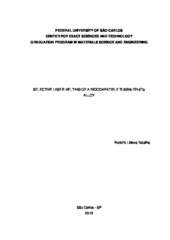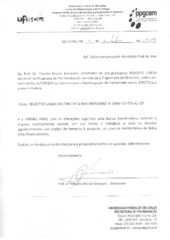| dc.contributor.author | Batalha, Rodolfo Lisboa | |
| dc.date.accessioned | 2019-11-19T13:47:01Z | |
| dc.date.available | 2019-11-19T13:47:01Z | |
| dc.date.issued | 2019-08-12 | |
| dc.identifier.citation | BATALHA, Rodolfo Lisboa. Selective laser melting of a biocompatible Ti-35Nb-7Zr-5Ta alloy. 2019. Tese (Doutorado em Ciência e Engenharia de Materiais) – Universidade Federal de São Carlos, São Carlos, 2019. Disponível em: https://repositorio.ufscar.br/handle/ufscar/12026. | * |
| dc.identifier.uri | https://repositorio.ufscar.br/handle/ufscar/12026 | |
| dc.description.abstract | Neste trabalho, estudou-se uma nova rota de fabricação de peças de uma liga biocompatível. Assim, uma liga Ti-35Nb-7Zr-5Ta (% em peso) biocompatível foi processada por fusão seletiva a laser (FSL). Os principais parâmetros de FSL foram determinados para a liga, expandindo o portifólio de materiais fabricados por FSL. Considerando que a composição da liga estudada era relativamente nova quando se trata de FSL, algumas amostras foram produzidas por fundição em coquilha de cobre. As propriedades do pó da liga foram analisadas e trilhas simples foram depositadas de forma a definir o melhor conjunto de parâmetros para produzir amostras compactas com densidade relativa de 99,0%. As características microestruturais das amostras da liga TNZT produzidas por FSL foram investigadas, e observou-se uma estrutura de solidificação colunar-dendrítica, enquanto nas amostras fundidas se obteve uma estrutura dendrítica de grãos equiaxiais. Uma estrutura monofásica Ti-β foi identificada nas amostras de FSL, enquanto que uma matriz de Ti-β com ripas de martensita α” foi observada nas amostras de fundição. A análise EBSD das amostras construídas por FSL mostrou grãos colunares crescendo epitaxialmente através de várias camadas, com direção preferencial do crescimento de grãos, diferentemente da estrutura de grãos sem orientação preferencial observada nas amostras de fundição. As amostras de FSL apresentaram resistência mecânica ligeiramente inferior do que as amostras fundidas em coquilha, relacionado a estrutura de grãos nas amostras produzidas por FSL. A formação de textura cristalográfica foi avaliada por meio da construção de cilindros por FSL com diferentes orientações, resultando em estruturas distintas de grãos e texturas cristalográficas. Em seguida, alguns protótipos foram fabricados, comprovando a viabilidade de fabricar peças de uma liga biocompatível com geometria complexa pelo FSL. Finalmente, foi proposta uma alternativa para maximizar as propriedades pseudoelásticas da liga Ti-35Nb-7Zr-5Ta (% em peso), e uma abordagem inovadora é proposta com a formação de uma estrutura oligocristalina, combinando manufatura aditiva a um tratamento térmico isotérmico simples. | por |
| dc.description.sponsorship | Coordenação de Aperfeiçoamento de Pessoal de Nível Superior (CAPES) | por |
| dc.language.iso | eng | por |
| dc.publisher | Universidade Federal de São Carlos | por |
| dc.rights | Attribution-NonCommercial-NoDerivs 3.0 Brazil | * |
| dc.rights.uri | http://creativecommons.org/licenses/by-nc-nd/3.0/br/ | * |
| dc.subject | Manufatura aditiva | por |
| dc.subject | Fusão seletiva a laser | por |
| dc.subject | Ligas de Ti | por |
| dc.subject | Liga biocompatível | por |
| dc.subject | Pseudoelasticidade | por |
| dc.subject | Estrutura oligocristalina | por |
| dc.subject | Additive manufacturing | eng |
| dc.subject | Selective laser melting | eng |
| dc.subject | Ti alloys | eng |
| dc.subject | Biocompatible alloy | eng |
| dc.subject | Pseudoelasticity | eng |
| dc.subject | Oligocrystalline structure | eng |
| dc.title | Selective laser melting of a biocompatible Ti-35Nb-7Zr-5Ta alloy | eng |
| dc.title.alternative | Fusão seletiva a laser de uma liga Ti-35Nb-7Zr-5Ta biocompatível | por |
| dc.type | Tese | por |
| dc.contributor.advisor1 | Kiminami, Claudio Shyinti | |
| dc.contributor.advisor1Lattes | http://lattes.cnpq.br/5443002033733395 | por |
| dc.contributor.advisor-co1 | Gargarella, Piter | |
| dc.contributor.advisor-co1Lattes | http://lattes.cnpq.br/4641435644243916 | por |
| dc.description.resumo | On this work, a novel manufacturing route for processing parts of a biocompatible alloy is studied. Therefore, a biocompatible Ti-35Nb-7Zr-5Ta (wt%) alloy was processed by selective laser melting (SLM). The main SLM processing parameters were defined for the alloy, expanding the mix of materials to be manufactured by SLM. Considering that it is a relatively new alloy composition when it comes to SLM, some samples were also produced by Cu-mould suction casting for comparison. The powder properties were analyzed, the single tracks approach was used, and the best set of parameters were determined to produce bulk samples with relative density of 99.0%. Microstructural features of parts of the TNZT alloy produced by SLM were investigated and a fine columnar-dendritic solidification structure is observed in the as-built samples, whereas an equiaxed dendritic structure was seen in the as-cast samples. A β-Ti single phase structure was identified in the SLM samples, while a β-Ti matrix and α” martensitic laths were observed in the suction-cast samples. The EBSD analysis of the as-built samples shown columnar grains growing epitaxially through several layers, with preferential direction of grain growth, opposed to randomly oriented grains observed in the as-cast samples. The as-built samples presented slightly lower mechanical strength, as a result of the grain structure in the samples produced by SLM. The formation of crystallographic texture was assessed by building cylinders by SLM with different orientation and distinct grain structure and crystallographic textures were developed. Then, some prototypes were manufactured, proving the feasibility of manufacturing parts of a biocompatible alloy with complex geometry by SLM. Finally, an attempt to maximize the pseudoelastic properties of the Ti-35Nb-7Zr-5Ta (wt%) alloy is performed and an innovative approach is proposed to obtain an oligocrystalline structure, combining additive manufacturing with a simple isothermal heat treatment. | eng |
| dc.publisher.initials | UFSCar | por |
| dc.publisher.program | Programa de Pós-Graduação em Ciência e Engenharia de Materiais - PPGCEM | por |
| dc.subject.cnpq | ENGENHARIAS::ENGENHARIA DE MATERIAIS E METALURGICA::METALURGIA DE TRANSFORMACAO | por |
| dc.description.sponsorshipId | CAPES: código de financiamento - 01 | por |
| dc.publisher.address | Câmpus São Carlos | por |
| dc.contributor.authorlattes | http://lattes.cnpq.br/7468067243817337 | por |


